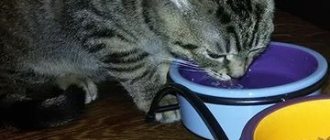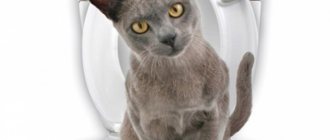If a bone or other foreign object is stuck in a cat's throat, the condition is accompanied by severe coughing, drooling, and the inability to swallow food. The owner must be able to recognize when the animal is reflexively coughing up grass or fur, and if the condition is dangerous and first aid should be provided to the pet. And also know when it is necessary to urgently contact a veterinary clinic.
Veterinarians categorically do not recommend giving your pet meat with bones, since bone fragments are the main reason why a cat chokes and can die.
About signs of trouble
Such troubles most often happen if bones are present in the pet's diet.
In general, veterinarians do not advise giving them and relying on the animal’s sharp teeth. Any meat, be it chicken, pork, lamb, must be separated from the bones and offered only the crumb. First of all, you need to determine the signs that clearly indicate that your pet is choking, that there is something in her throat or throat. This is usually indicated by the urge to vomit. They may be unsuccessful and escalating.
A cat is simply unable to swallow food, water, or even its own saliva. Another typical sign that an animal is choking is intense vomiting.
Sometimes it happens that the owner just thinks that something is wrong with the pet, and he has a piece of food stuck in his throat. In fact, it may just be a wave-like cough. But this sign indicates a problem with the pet’s respiratory system. The owner must learn to distinguish a cat's cough from the urge to vomit, bones or other objects stuck in the throat. A cough, which frightens owners and resembles the urge to vomit, sometimes indicates stomach diseases, gastritis, for example, infectious diseases. It can also be a manifestation of abnormalities in the development of the pharynx. This is very rare in cats, but dog owners need to know that sharpeis, pops and bulldogs are at risk for this pathology. In rare cases, vomiting and choking may be a symptom of an allergy. Then other signs must be present.
False suffocation
The above symptoms may not always mean getting stuck. Choking can occur due to other reasons:
- allergic reactions to household items, food;
- severe spasm of the larynx;
- the cat may have swallowed a hairball, which causes a gag reflex;
- the body's reaction to the drug used;
- difficult passage of food through the esophagus, when the cat must swallow large amounts of dry or other food;
- gag reflex due to pressure of food on the vault of the larynx.
Important! Any of the above conditions can be dangerous for a pet, since in the larynx the area of the respiratory and digestive tracts are located close to each other.
What to do if a cat chokes on a bone?
A cat choked on a bone, any pet owner should know what to do in such cases. The main thing in such a situation is not to panic, but to quickly help the pet, otherwise it may simply die.
Below we will describe the symptoms of the phenomenon, which will help a person quickly identify signs of trouble in a pet and the sequence of actions to prevent death for the animal.
How does a pet behave if it chokes on some food?
The cat choked on a fish bone
Typically, an animal will get into trouble if its diet contains food that contains hard or semi-solid parts, such as bones. Veterinarians do not recommend giving cats this food. It is better to feed them only soft parts of fish or meat. You can't rely on your pet's teeth.
The first priority for a person is to identify symptoms that indicate that a kitten or adult animal is choking. To do this, you need to take a closer look at your pet. If he chokes on, for example, a fish bone, the following symptoms usually appear:
- The presence of a hard object in your pet's throat is indicated by the urge to vomit. If the bone is stuck deep, then the cat’s attempts to remove the bone by vomiting will increase, but they will not bring success.
- Usually in this state he cannot swallow small pieces of food or drink water. Panicking cat can't swallow his own saliva.
- Signs of vomiting may not appear, but severe vomiting may begin. If its intensity is high from the very beginning, it means that the animal actually choked on a solid piece of food.
Sometimes the owner just thinks that something has happened to his pet. Usually a person is mistaken if a cat begins to tremble, has convulsions, opens its mouth, and coughs. It may just be a wave-like cough, which makes it clear that there is trouble in the pet’s respiratory system.
Therefore, a person must be able to distinguish these symptoms from vomiting that appears in a pet when a bone gets into the throat.
If the cat coughs a lot, then you need to call the veterinarian, as this means that the pet has an infectious lesion or stomach disease. Most often, such symptoms appear in a pet due to a cold or gastritis.
Some cats, quite rarely, have an abnormal throat structure that can cause symptoms similar to choking on a hard object. The same urges (vomiting, choking) appear in cats with an allergic lesion, but other symptoms should also arise.
How to help your pet with vomiting and choking
Cat choked on a bone
If the owner knows that before signs of trouble appeared the animal ate bones, then most often they cause vomiting if they fail to pass through the pet’s throat. Therefore, a person must act quickly.
First, a choking cat is checked to ensure adequate breathing. If she breathes freely enough, it means the foreign body is shallow. A person can try to get it out with tweezers. It will not be easy for one owner to do this; an assistant will be needed, since an animal panicking due to fear of suffocation will scratch, twist, and run away from people.
Therefore, the assistant must hold the pet tightly and bring it to a bright light source. The owner of the pet opens the cat's mouth and, if the tip of the bone is visible, tries to grab it with tweezers and then remove it from the pet's throat.
- There is another way to fix the problem. You need to pour a little vegetable oil into the mouth. It will force the bone into the animal’s stomach and help it put its respiratory system in order.
- Owners who have experience with cats recommend in such situations to lower the pet upside down (as mothers do with their children if the child is choking), and then hit the cat hard on the chest or slap it on the back. This will help shake the bone out of your throat.
- You can try to artificially induce vomiting. Then the pet's throat will contract and push the bone out. You need to act quickly, but do not use force, as this will cause stress in the cat.
Kittens often choke due to the speed of eating food. If this happens, the baby is picked up and warm water is poured into his mouth. You can lightly pat your pet on the back with your palm.
If the owner did not notice in time that the cat was choking and the pet’s tongue turned blue, he should urgently take him to the veterinarian or call a specialist to his home.
It is forbidden to give your pet vodka or alcohol, or laxatives. Sometimes surgery may be necessary.
First aid
A kitten that has choked on milk can be lightly tapped between the shoulder blades, tilting it slightly. If your cat chokes on a fish bone, you can try to remove it yourself. Algorithm of actions:
- Wrap the cat in a thick blanket so that the paws are firmly secured.
- Examine the pharynx with a flashlight.
- Using a syringe without a needle, pour in a little vegetable oil to make the foreign body more pliable for removal.
- Use tweezers to carefully remove the bone.
If it was not possible to remove the bone, you can use this method:
- Kneel down, fixing the cat between your legs with your head away from you.
- Use sharp movements to squeeze the sides 4-5 times, making sure that the impact on the ribs is not too strong, otherwise you can break the bones.
- Cats cough and cough up foreign objects.
Return to contents
How to do artificial respiration?
If a cat has swallowed a bone and is choking, you should immediately call a veterinary ambulance and begin artificial respiration as follows:
- Place the animal on its side.
- With sharp movements, squeeze the chest 5-6 times towards the neck.
- Exhale 1 p. in the cat's nose.
- Continue massage of the sternum (80-120 r/min.).
- Alternate exhaling into the nose and massaging: 15 seconds. massage/exhalation 10 times.
Veterinarians prohibit giving a cat laxatives, disinfecting the throat with alcohol, or using force when opening the mouth, this leads to a burn of the mucous membrane or dislocation of the jaw.
Symptoms: how to recognize pathology?
The presence of a foreign body in the pet’s body is indicated by an increase in temperature and a hot, dry nose. If a cat or kitten swallows a cotton swab, chewing gum, ribbon, or rubber toy and it gets stuck in different parts of the gastrointestinal tract, the symptoms are as follows:
- pain in the abdomen, in which the pet tries to curl up;
- refusal of food;
- frequent vomiting with almost no food, sometimes with blood;
- drowsiness;
- loss of activity, reluctance to play;
- constipation, scanty stool;
- slight increase in temperature, hot dry nose;
- weight loss;
- pallor and dryness of the oral mucosa due to dehydration.
Useful tips
Recommendations from specialists will help facilitate the examination of the animal, provide it with more qualified assistance in a critical situation and save a choking cat :
- When examining the mouth, use a flashlight, this will make it possible to quickly detect a foreign object.
- A pet can bite even if it is almost unconscious, so you should be careful.
- A choking cat may die from asphyxia. What the outcome of the incident will be largely depends on the speed of reaction of the pet’s owners.
When calling for help, the veterinarian may administer anesthesia to make it easier to examine the animal and get a good look at the foreign body in the mouth. In some cases, an x-ray, the use of an oxygen mask, and immobilization of the cat are necessary.
What to do if your cat chokes on a chicken bone
Sometimes a large piece of bone, greedily swallowed by a cat, gets stuck right in the esophagus. Unfortunately, it is impossible to independently remove a foreign body from the esophagus and stomach, and failure to provide assistance in this case risks the death of the animal. How can you tell if your cat has a bone stuck in her esophagus?
This condition is characterized by the following symptoms that appear immediately after a cat has swallowed a chicken bone:
- profuse drooling;
- urge to vomit;
- characteristic movements of the paws, as if the animal is trying to free its mouth from something.
To assess where exactly the foreign body has penetrated, you should secure the animal by wrapping it in a towel, carefully open its mouth and look into its throat, shining a flashlight there. If the bone is shallow, for example, you can try to pull it out with tweezers
But the best thing to do if a cat chokes on a chicken bone is to immediately take it to a veterinary clinic that has a gastroscope.
An experienced doctor, using a special tool, is able to grab and pull out the bone and make sure that the walls of the esophagus are not damaged, and if damaged, provide the necessary assistance.
Ingestion of bones into the respiratory tract is an extremely rare occurrence, but the possibility should not be ruled out. If the animal begins to choke, then first of all it is also necessary to examine the oral cavity and pharynx. When the cause cannot be identified, veterinary care must also be provided as quickly as possible.
Despite the fact that in most cases, eating chicken bones by cats ends happily, we cannot exclude a serious risk to the health and life of the pet associated with the consequences of eating bones, especially those that have undergone heat treatment, making them hard and brittle. Therefore, do not leave chicken bones on the table and place the trash can in an area out of reach of cats.
What canned food tastes best for cats?
RESEARCH ATTENTION! You and your cat can take part in it! If you live in Moscow or the Moscow region and are ready to regularly observe how and how much your cat eats, and also remember to write it all down, you will receive FREE SET OF WET FOOD. Project for 3–4 months
Organizer - Petkorm LLC
Project for 3–4 months. Organizer - Petkorm LLC.
Want to participate? Call!
When do you need a veterinarian?
The help of a professional doctor is necessary in the following cases:
- complete lack of knowledge about first aid;
- bleeding from the esophagus, hemoptysis;
- a pregnant cat choked, a full analysis of its health should be performed, an ultrasound should be performed;
- lack of normalization of the pet’s health after removal of the foreign object.
Note! Often, several small fish bones may become stuck in the esophagus. A person will take out 1 of them, the other will remain inside. Therefore, it is better to make sure of its complete absence by conducting a complete diagnosis of the body.
How does a pet behave if it chokes on some food?
Typically, an animal will get into trouble if its diet contains food that contains hard or semi-solid parts, such as bones. Veterinarians do not recommend giving cats this food. It is better to feed them only soft parts of fish or meat. You can't rely on your pet's teeth.
The first priority for a person is to identify symptoms that indicate that a kitten or adult animal is choking. To do this, you need to take a closer look at your pet. If he chokes on, for example, a fish bone, the following symptoms usually appear:
- The presence of a hard object in your pet's throat is indicated by the urge to vomit. If the bone is stuck deep, then the cat’s attempts to remove the bone by vomiting will increase, but they will not bring success.
- Usually in this state he cannot swallow small pieces of food or drink water. Panicking cat can't swallow his own saliva.
- Signs of vomiting may not appear, but severe vomiting may begin. If its intensity is high from the very beginning, it means that the animal actually choked on a solid piece of food.
Sometimes the owner just thinks that something has happened to his pet. Usually a person is mistaken if a cat begins to tremble, has convulsions, opens its mouth, and coughs. It may just be a wave-like cough, which makes it clear that there is trouble in the pet’s respiratory system.
Therefore, a person must be able to distinguish these symptoms from vomiting that appears in a pet when a bone gets into the throat.
If the cat coughs a lot, then you need to call the veterinarian, as this means that the pet has an infectious lesion or stomach disease. Most often, such symptoms appear in a pet due to a cold or gastritis.
Some cats, quite rarely, have an abnormal throat structure that can cause symptoms similar to choking on a hard object. The same urges (vomiting, choking) appear in cats with an allergic lesion, but other symptoms should also arise.
How to help your pet with vomiting and choking
If the owner knows that before signs of trouble appeared the animal ate bones, then most often they cause vomiting if they fail to pass through the pet’s throat. Therefore, a person must act quickly.
First, a choking cat is checked to ensure adequate breathing. If she breathes freely enough, it means the foreign body is shallow. A person can try to get it out with tweezers. It will not be easy for one owner to do this; an assistant will be needed, since an animal panicking due to fear of suffocation will scratch, twist, and run away from people.
Therefore, the assistant must hold the pet tightly and bring it to a bright light source. The owner of the pet opens the cat's mouth and, if the tip of the bone is visible, tries to grab it with tweezers and then remove it from the pet's throat.
- There is another way to fix the problem. You need to pour a little vegetable oil into the mouth. It will force the bone into the animal’s stomach and help it put its respiratory system in order.
- Owners who have experience with cats recommend in such situations to lower the pet upside down (as mothers do with their children if the child is choking), and then hit the cat hard on the chest or slap it on the back. This will help shake the bone out of your throat.
- You can try to artificially induce vomiting. Then the pet's throat will contract and push the bone out. You need to act quickly, but do not use force, as this will cause stress in the cat.
Kittens often choke due to the speed of eating food. If this happens, the baby is picked up and warm water is poured into his mouth. You can lightly pat your pet on the back with your palm.
It is forbidden to give your pet vodka or alcohol, or laxatives. Sometimes surgery may be necessary.
Preventive measures
For prevention purposes, you should follow the following rules:
- give the animal fish without small bones;
- do not feed chicken bones;
- use food based on age, for example, buy small dry food for kittens;
- Finely chop the meat for small kittens, do not leave large pieces near them for an adult cat.
Cats, just like people, can choke easily. Their digestive tract is quite thin and easily susceptible to mechanical damage. The pathological condition can be caused by grass, wool, fish products, and small children's toys. If a cat has a bone stuck in its throat, every owner should know what to do and what conditions to observe.
Prevention measures
Considering the reasons that provoke coughing in cats, it is more effective to prevent it than to treat an already manifested pathology.
The appearance of cough in cats is not such a rare occurrence. A cat can cough for various reasons, and this symptom can manifest itself in different variations: annoying, painful, dry, wet, quiet cough.
Your cat may be coughing due to choking.
Most often you can hear a gagging sound, as if the animal was choking on something. It should be noted that cough is not an independent disease, but only a symptom of a disease.
Experts distinguish several types based on the following components:
- duration;
- force;
- timbre;
- discharge;
- Times of Day.
Causes of cough
There is no need to panic too much, since the lumps may come out when the cat defecates, but if this does not happen, some measures should be taken to help the animal get rid of such trouble. It is quite possible that the pet will be able to cough up the foreign body itself.
If other signs are observed with this type - shortness of breath, rapid shallow breathing, fever, you should immediately contact the clinic
.
Diagnosis and treatment
X-ray of the respiratory organs.
The cause is determined through X-rays of the respiratory organs, laboratory tests of blood tests, sometimes a study is carried out for the presence of a viral infection, and less often a biopsy of the bronchi is performed. When helping your pet, you cannot be guided by one symptom. It is necessary to establish an accurate diagnosis.
Algorithm of actions
- Don't panic and call an ambulance. Or go to the hospital yourself.
- Open the throat of the choking person and see if the bone is visible. If yes, remove it with tweezers (at home you can use eyebrow tweezers).
- Do not give the victim a large piece of bread! He can only push the stuck object further.
- Another method is used quite often - attach a clean sponge to the tape, let the choking person swallow it, then pull the tape. But this can seriously injure the esophagus! You can't do that!
- If a small child chokes on a fish bone, you should immediately go to the doctor!
What should you do if you choked on a fish bone and started bleeding? You need to call an ambulance immediately. This indicates an injury to the esophagus.
When fish remains become lodged in the esophagus, the victim begins to cough violently, choke, and flail their arms. In this case, at first there may be severe redness of the skin. If pallor is observed, this indicates that a spasm has occurred and the person’s oxygen supply is limited.
Bleeding and suffocation may occur. This is a reason to seek medical help immediately. There is no need to think that the symptoms will go away on their own. The bone may be deeper than the tonsils - then the consequences will be very serious.
If first aid recommendations do not give results, then the fish bone is removed in the hospital. To do this, the nurse shines a flashlight into the patient's throat and uses a special spoon to hold the tongue. Meanwhile, the doctor removes the foreign body with hospital tweezers.
When a person chokes on a fish bone and it is stuck deep, you can induce vomiting. For this, a solution of potassium permanganate is used. In any case, the foreign object will be eliminated. You can use the Heimlech method.
When do you need to see a doctor?
If your cat has a bone stuck in its throat, veterinary help is needed for the following symptoms:
A pet's fainting condition requires immediate doctor intervention.
- eye rolling;
- shortness of breath or lack thereof;
- loss of consciousness;
- bleeding from the mouth;
- cyanosis of mucous membranes;
- the foreign object cannot be pulled out.
The veterinarian will prescribe intensive care or surgery to remove the foreign body. When a cat has choked on a fish bone and it has been removed, consultation with a veterinarian is also required. A foreign body can injure the structures of the pharynx and esophagus, causing secondary infection and abscess formation. To prevent complications, your veterinarian will recommend drug therapy.
Additional symptoms
Whatever the cause, cough and shortness of breath cannot diagnose the disease. In this case, the complex clinical picture should be considered. When collecting information about the disease, not a single symptom should be discarded.
To make a diagnosis, you should pay attention to:
- general condition (depression, lethargy, anxiety);
- food intake (reduced or the animal refuses it completely);
- drinking water (increased thirst may indicate diabetes, and choking is an additional symptom from dry mucous membranes);
- temperature indicators (an increase in general temperature may indicate inflammatory processes in the lungs and bronchi);
- nasal discharge (mucous, purulent);
- discharge from the eyes (viral rhinotracheitis, toxoplasmosis);
- diarrhea or constipation (bacterial or viral infection, toxoplasmosis, toxocariasis).
Wheezing when breathing
Wheezing when breathing can be dry and wet (squelching). To hear better, you need to use a stethoscope or at least put your ear to your chest.
The cause of inflammatory processes can be either hypothermia or overheating of the animal. At this moment, the body’s resistance decreases, and the virulence of microorganisms increases.
Dry wheezing indicates initial inflammatory processes in the bronchi and lungs. At this moment, the mucous membranes are dry, and their friction is expressed by wheezing, and the cough is manifested by barking sounds. After some time, exudate begins to ooze out and the wheezing becomes moist. At this time, expectoration occurs. The cough becomes softer, in this case they call it a wet cough. The inflammatory process is always accompanied by an increase in body temperature, depression, and refusal to feed. Initially mucous discharge begins to flow from the nasal openings, and then fibrinous and purulent. The nostrils become covered with dried crusts, which make breathing even more difficult.
Difficulty breathing and wheezing can occur with viral rhinotracheitis. In this case, a whole complex of symptoms is recorded. However, all of them may not be typical, so diagnosis should be carried out by a specialist.
Cat gasps with tongue hanging out
A cough and a tongue outstretched in a cat cannot be a diagnostic symptom, it’s just something that makes the animal feel better. This is often how cats cough during an asthmatic attack. Rapid bronchospasm makes breathing difficult, and the animal reacts by coughing. After a few minutes, the spasm gives way to relaxation and the animal calms down.
If this happens for the first time, there is no need to be afraid, but you should consult a doctor.
Choking while sleeping
Shortness of breath and difficulty breathing during sleep has the same causes as all others. However, if the cat sleeps separately from the owner, then monitor how often her exacerbation becomes difficult.
While awake, the cat often licks nasal discharge with its tongue and this makes it impossible for them to dry out. During sleep, crusts block the nasal passages, and this can cause difficulty breathing.
The bone entered the digestive system
Often the animal is given food containing chicken and fish bones. The latter option is especially dangerous, since such bones are very thin and can pierce right through the digestive tract. This will lead to damage to internal organs and death of the pet. Therefore, it is better to immediately find out what to do if a cat has a bone stuck in its throat.
Large chicken bones are dangerous because they can cause instant bleeding. You can't leave a bone in your throat. It should be removed as soon as possible, before minimal damage is done.
How to remove a bone from a cat's throat
If your cat has something stuck in its throat, your veterinarian will tell you what to do. You can find out all the stages of removing a foreign object during a general examination.
If an object is stuck in the larynx, you can remove it yourself. Initially, a person should find out how deep he went and whether there was serious damage.
- If the bone is stuck on the surface of the larynx, there is no extensive damage to the mucous membrane and soft tissue underneath, you can remove it yourself.
- If the object is located deep in the larynx or digestive tract, heavy bleeding occurs, the person cannot cope with fear, it is better to immediately consult a veterinarian.
Kittens can often choke on food because they pass too much of it. They are small enough to hold them in place and quickly remove the foreign object
Therefore, it is important to know what to do if a kitten chokes
During the removal of a foreign object, the cat may dodge, run away, bite, or interfere with the procedure. Therefore it should be recorded. To do this, you can use ordinary belts that are pulled from above the animal’s body. You can ask another person to hold the paws.
For your information! If first aid is provided by a veterinarian, he may give a sedative or sleeping pill, which will temporarily immobilize the pet.
If your cat is choking, there may be damage to her digestive system. Therefore, you should thoroughly wash your hands with germicidal soap before attempting to reach the object.
1 finger is inserted into the throat and the surrounding tissues are felt. In this case, it is better to use a flashlight to illuminate the space. If you feel an object, you should grab it and slowly pull it out. This cannot be done quickly, as parts of the sharp edges may remain inside, for example, if a cat choked on a fish bone.
How to secure a pet
If you can't get it out manually
If you couldn’t cope on your own, what to do if your cat has a bone stuck in its throat, the veterinarian will tell you. A special device with a camera will be used to examine the digestive system.
If possible, the doctor will remove the object without injuring the animal. If they are unavoidable, your doctor may recommend surgery.
If the cat begins to lose consciousness from suffocation
If a cat gradually loses consciousness, this means that its larynx is completely blocked. Oxygen does not enter the respiratory tract, so rapid death is possible without first aid.
After removing the foreign object, breathing may not begin. Therefore, artificial respiration should be performed. Gauze is placed on the cat's or kitten's face, through which air is inhaled into the oral cavity. At the same time, pressure is applied in the area of the heart with your fingers.
Features of the pharynx and esophagus in cats
The digestive tract of an animal begins with the oral cavity. Food is chewed before entering the throat. There are 2 parts in it:
If a foreign object gets stuck in the throat, it is dangerous because it can move into both the digestive and respiratory systems. The pharynx is a hollow organ through which the bolus of food enters the esophagus.
A veterinarian's examination is a last resort in such a situation.
For your information! The esophagus is constantly in a dormant state until food arrives. It contains muscle tissue that moves the food bolus down the gastrointestinal tract. Its cavity is lined with a mucous membrane, under which there are glandular cells.
When food enters the esophagus, muscle tissue is activated, pushing it towards the stomach.
What to do if your dog or cat chokes on a bone?
When a pet appears in the house, all attention is focused on it: you want to create maximum comfort and coziness so that your beloved furry grows and develops in a good atmosphere. But if you decide to take on such responsibility, you must understand that his life is now completely in your hands
This means that any owner must have at least minimal knowledge in order to help their pet in a timely manner in the event of any unforeseen situation. And one of these is, if he suddenly chokes, what should he do? After all, illiterate actions or lack thereof can even lead to death. What do veterinarians say about this?
In fact, an animal can choke on almost anything, because it is restless, like a child, and does not always understand the danger its actions can lead to. “My dog or cat choked. What to do?".
Often this is the question that concerned pet owners turn to the veterinarian with, often without even fully understanding what this concept includes. Typically, the diet of pets, especially dogs, contains bones - chicken, beef, fish or any other.
And, despite the fact that many veterinarians constantly warn that eating these seeds is an unsafe activity, many owners still hope for chance. So it turns out that a sharp sliver gets stuck in the throat, esophagus, or, even worse, the respiratory tract.
The main symptoms of the presence of a foreign body in the pharynx or esophagus are constant and often unsuccessful urge to vomit, which has an increasing character. The animal begins to rush around, trying to use its paw to get the interfering object out of its mouth, sometimes it cannot swallow not only food or liquid, but even its own saliva.
If the stuck object moves further into the esophagus or stomach, continuing to irritate its walls with its sharp ends, severe vomiting may occur, almost uncontrollably. But sometimes it happens that the pet is not choking, but it’s just a severe cough.
What to do if an animal chokes?
Here the count may already be going on for minutes, however, under no circumstances should you panic. If you see that the breathing is more or less even, then try to pick up the pet and open its mouth with one hand, examine the throat, perhaps you can see the object that is stuck there.
In fact, an animal can choke on anything: a bone, a sliver of a stick, a piece of a toy, even your sock, don’t be surprised, there have been different cases! First aid in this case is simple: if you see a foreign object, try to reach it with your hand or tweezers.
To improve its sliding down the throat, you can pour a tablespoon of vegetable oil into the animal’s mouth, but only if the foreign body is clearly visible and can be moved.
Sometimes pet owners try to make them vomit - a dubious method, but sometimes still effective. If it is a dog, then you can try to turn it head down in your hands and literally shake out the stuck object. This method also sometimes works with cats, but it is more difficult, since they are constantly trying to curl up into a ball.
If you see that you cannot remove the foreign object on your own, and the animal continues to suffer, then do not waste time and take the animal to the veterinary clinic as quickly as possible. Do not under any circumstances try to disinfect your pet’s throat with alcohol or give a laxative – this simply does not make any sense.
Trying to push the bone inside the stomach is also not recommended, as you risk injuring the walls of the esophagus. In particularly severe cases, in order to remove a stuck object, the animal has to undergo general anesthesia and remove it using the endoscopic method.
To ensure that such situations happen in your and your pet’s life as little as possible, watch what he plays with, what he eats and, of course, do not leave unattended with toys that he can chew and swallow.
First aid
The larynx of cats is highly sensitive. In the event of a spasm, the respiratory system is blocked, resulting in suffocation. If your cat chokes on a fish bone, something should be done immediately.
First aid:
- Immobilize your pet by wrapping it in a towel or other thick cloth. You only need to leave your head outside. It’s great if one person holds the cat, and the second one takes the foreign object out of the mouth.
- Examine your cat's mouth. To do this, move her head back a little, press her lower jaw with your finger to open her mouth. If the bone is clearly visible, then pull it out with tweezers (you cannot put your fingers into the mouth, as there is a possibility of pushing the foreign object even deeper). A deeply stuck bone that is difficult to see cannot be removed. Therefore, it is better not to try to do this, as there will be more harm than good.
- Try to dislodge the stuck object by firmly and at the same time gently tapping it between the cat's shoulder blades with the palm of your hand. To do everything correctly, you will need to place your pet on the floor, with its muzzle away from you, with its hind limbs held between your knees. Place your palms on both sides of the cat's chest and squeeze it four to five times, approximately 1/3 of the way, with quick jerks. This is done so that the pet begins to cough and can thus push out a foreign object. You cannot press too hard, as there is a danger of breaking the animal’s ribs.
- If the cat is unconscious (which can happen as a result of asphyxia), then you need to act differently. Open your pet's mouth as wide as possible and look for the stuck object; if you can see it, remove it with tweezers.
Remove any liquid that has accumulated in the cat’s mouth using a clean rag or napkin (cotton wool cannot be used, as it consists of fibers that can stick to the surface of the mouth and aggravate the situation).
Place your cat on its side with its head lower than its heart to allow saliva to flow out. After clearing the respiratory tract, perform artificial respiration from mouth to nose; if it is done quickly, the pet will be saved.
A veterinarian should examine a cat that has previously choked, since it would be useful for its owner to know how severely the respiratory organs are injured and whether treatment is required. This is if the stuck object was removed. It is important that your pet is calm before being examined by a doctor.
If it was not possible to clear the cat’s airways on your own, you must immediately contact a veterinarian. Before leaving, you should notify the doctor about your visit and ensure that your pet is transported as comfortably as possible.
Cat cough: causes and types
A sharp release of air from the lungs can be reflexive - a protective reaction to external stimuli, and symptomatic - accompanying some underlying disease. Those. This is not a separate disease, it is always a sign of something more serious.
Reflex cough spasm occurs in the following cases:
- the presence of foreign bodies in the airway or esophagus (the cough will continue until the foreign object is removed or coughed up);
- changes in the inhaled air: caustic gases, smoke, any sharp-smelling substances or fine powders (flour, mustard powder, peppers, etc.).
Symptomatic accompanies:











